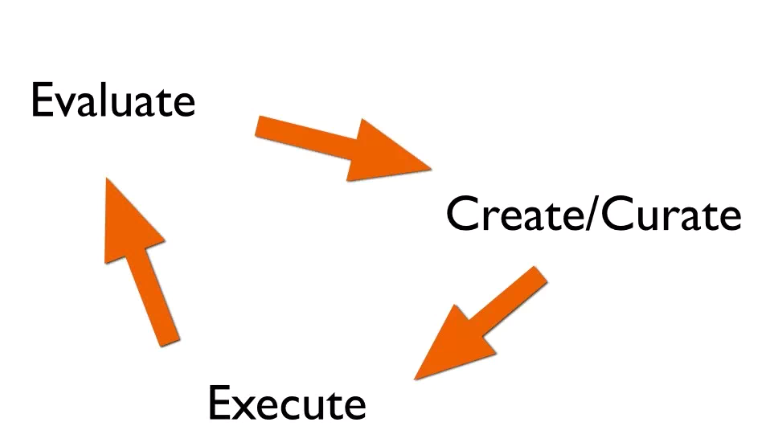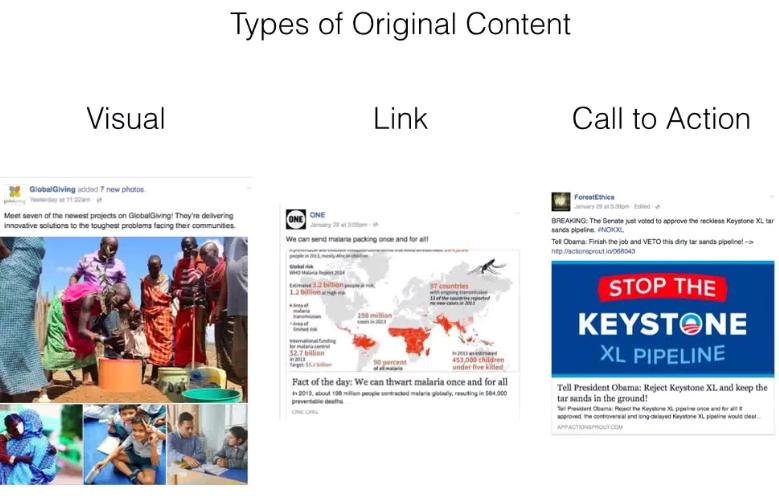Our friends at ActionSprout have teamed up again with regular Epolitics.com contributor Beth Becker to host a webinar with even more great advice and tips on social media marketing. Kim Blomgren has written up the latest installment of this ongoing series, which tackled the tough issue of navigating the social content cycle. Be sure to check out Kim’s earlier wrap-up of the first session, Five Hacks to Make the Facebook Algorithm Work for Your Cause.
Since Facebook has a seemingly endless array of post types, ad types to go with them, and analytics to understand how they did, it’s easy to get overwhelmed. However, with Beth’s three-point content cycle model, it’s easy to dive in and start creating a strategy designed for your specific audience. Here’s how:
1. Evaluate
While the content cycle is, yes, a cycle, the best place to jump in is with evaluation. Start by asking yourself a few key questions: “what are we trying to achieve?”, “what are we trying to say/what is our message”, “who are we speaking to” and “what response are we looking for?”

You’ll want to match your answers to these questions to the types of content you create and to the social networks where you choose to post. For example, teens prefer Instagram, Twitter is skewed male, and approximately 80% of a politician’s Facebook audience lives in his or her district.
Beyond answering these questions, it’s sage to evaluate timing. Beth recommends creating an editorial calendar that maps to your campaign calendar and outlines things like teasers and live-tweeting events. Fill in your calendar with the content you need to support your campaign goals and activities, and don’t worry at this point about any holes that might be in your calendar.
Last, make sure that you evaluate what actions you want your social followers to take and integrate them into your strategy. For example, are you interested in gathering email addresses, signing up volunteers or gathering donations? This desired outcome needs to play a significant role in your content strategy.
2. Create and Curate
The second stop on the content cycle is creation. While it’s understandable to want to start here, you really should prep (evaluate) first in order to get a desired result. And once you’re ready to dive into the creation, start by making content that directly address the answers from your evaluation. Content should map message to audience and network and feed the desired outcome. Remember that all content you create should be branded by your organization. That way should it be shared or go viral, everyone knows where it came from.
When thinking about what type of content to create, consider that there are several types of original content: Images, Links, Actions, Videos, etc. Again, the type of post you choose should map to your goal. For example, if you are interested in collecting email addresses, then a call to sign a petition may be your best strategy.

Most organizations don’t have the resources to create 100% of their content needs. And that’s just fine, as Beth recommends that organizations follow the 80/20 rule, creating 20% of their own content, curating the remainder. Because curated content helps fill in the holes in your content calendar, it should map to your strategy. Make sure it’s quality and fits your page (message, type of content, etc.) Each audience is different, so you need to know what will resonate with your audience when looking at which content to curate.
3. Execute
Having said that, not everything you post should or needs to be 100% on message. While it does need to resonate with your community, if all posts were strict message-based content, your audience would honestly get bored. Mix it up with news related to your issue, humor, and inspirational content. For example, if you are in the Carolinas, a post celebrating Duke’s NCAA win may not be on message, but will certainly rally a portion of your audience. Beth recommends following the 60/40 rule here with 60% of content off-topic, but relevant to your community and 40% dedicated, on topic content.
When and how often you post should all be data-driven. Examine your Facebook analytics and create your own tracking mechanisms (if needed) to determine when your content gets the most interaction, and what the ideal amount of content is for your audience. Balance curiosity with functionality — don’t abuse link bait and instead create headlines that will get clicked but aren’t overly sensationalistic.
Last, make sure to tailor your content to the platform. With your audience analytics in hand, post content on each platform that you know your audience will want and appreciate — e.g. your Twitter followers are likely looking for something very different than your YouTube audience.
4. Evaluation
We now come full circle to evaluation. After your initial evaluation and strategizing, content creation and posting, the second round of evaluation helps you understand what worked and what didn’t. Which pieces of content did your audience engage with and which went largely unseen? Using this information, begin the cycle anew, fine-tuning your strategy to maximize audience engagement.
Audiences change and new people will join your community; Facebook milfs near me will create new post types and technology will evolve. For these reasons and more, it’s important to experiment and try new things. If something bombs, it will be like the proverbial tree that fell silently in the woods and you’ll certainly learn what doesn’t work. And if it succeeds, you’ve discovered yet another way to interact with your audience and serve up content that validates their sense of social self.
Looking forward to the next installment, Kim and Beth! – cpd


[…] How to navigate the social content cycle […]